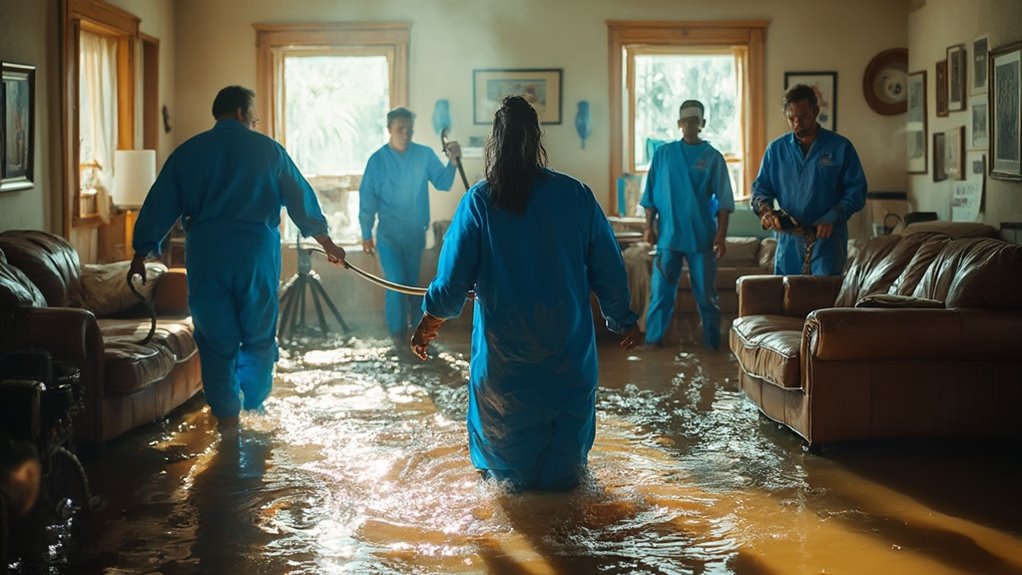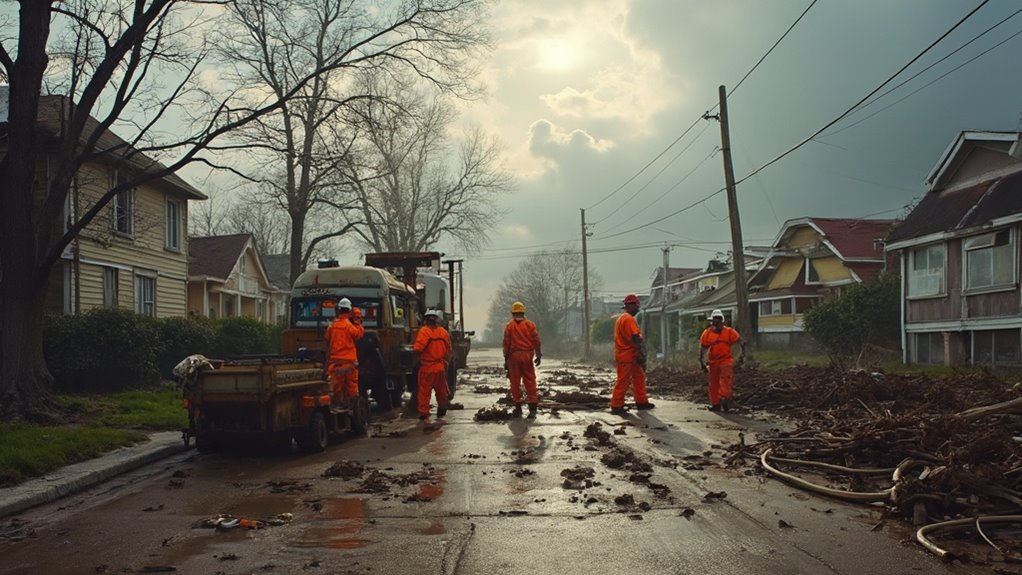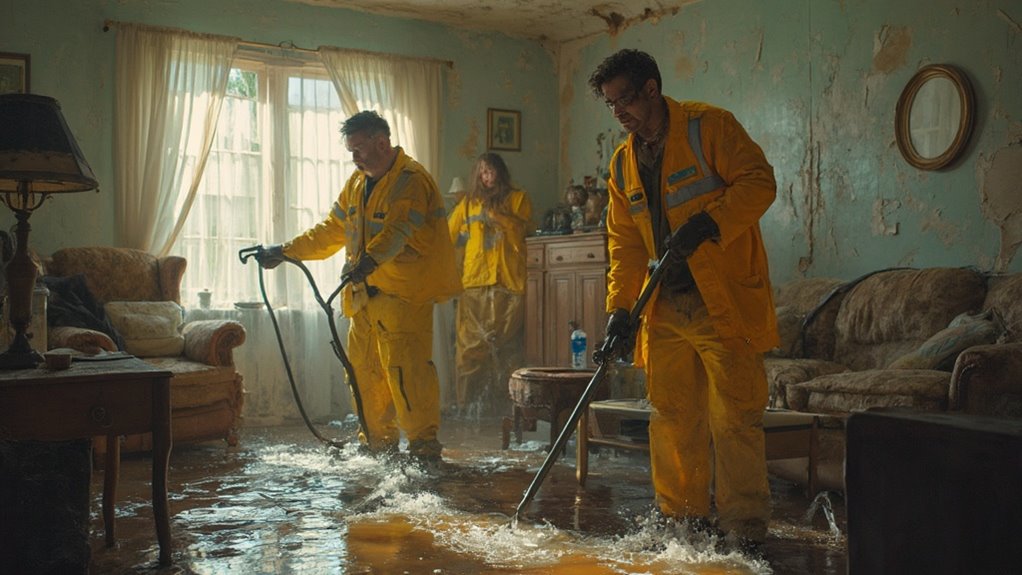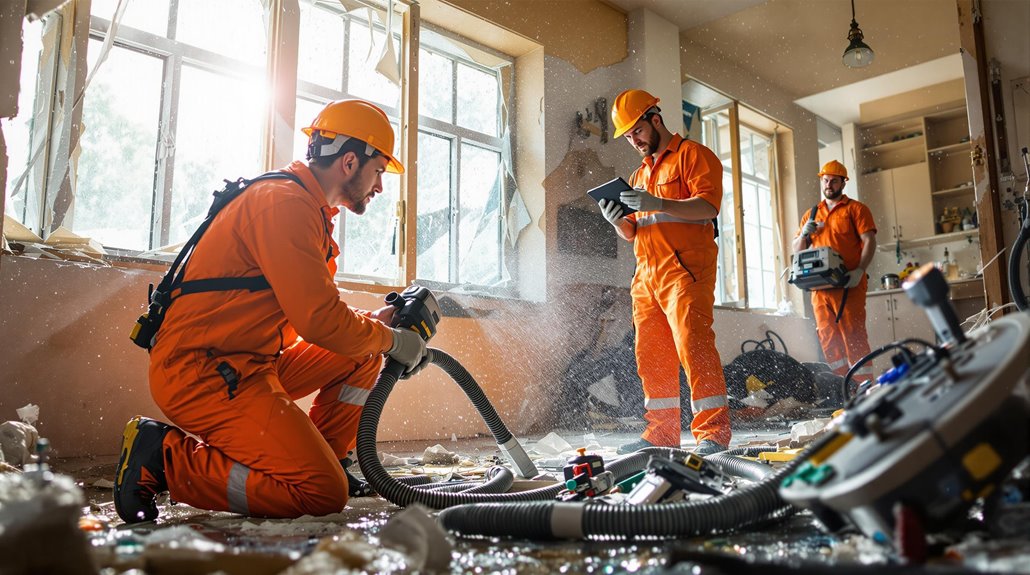When emergencies occur, Care Pro's 24/7 emergency restoration services are here to help you every step of the way. Their expert team quickly assesses the damage and initiates fast water extraction and cleanup to prevent further issues. With services like mold remediation, biohazard cleanup, and specialized care for sensitive materials, you can trust them to restore your property efficiently. They prioritize clear communication and rapid response times, ensuring you feel supported during stressful situations. If you want to uncover how they can assist during your time of need, there's even more insight ahead.
Key Takeaways
- Care Pro offers 24/7 emergency restoration services, ensuring rapid response times for effective damage assessment and immediate action.
- Their team provides comprehensive support, including water extraction, mold remediation, and biohazard cleanup to safeguard your property.
- Advanced technology, like predictive analytics and IoT integration, enhances their service efficiency and situational awareness during emergencies.
- Care Pro prioritizes empathetic communication, ensuring clients are informed and reassured throughout the restoration process.
- With a focus on disaster preparedness, Care Pro is equipped to handle increasing natural disaster incidents effectively.
Overview of Restoration Services

Understanding the various restoration services available can make a vital difference when disaster strikes. Many people underestimate the importance of emergency preparedness and the role effective restoration techniques play in mitigating damage. Initially, an assessment is essential. Professionals evaluate the extent of the damage, allowing them to formulate a tailored response plan. Emergency restoration services provide immediate relief from disaster impacts, which is crucial in the early stages of recovery. 24/7 emergency water extraction services are part of this immediate response strategy, ensuring that help is available whenever needed.
Once the assessment is complete, the clean-up process begins. This involves removing damaged materials and debris to prepare your property for reconstruction. Specialized restoration services address specific issues like water damage, fire and smoke damage, and mold remediation, ensuring a thorough approach.
After clean-up, reconstruction takes center stage. Skilled teams repair or replace damaged components, returning your property to its pre-disaster condition. Advanced equipment, such as moisture meters and thermal imaging cameras, aids in detecting hidden issues, while dehumidifiers and air movers quickly dry affected areas to prevent further damage.
Ultimately, understanding these restoration services not only helps you respond effectively but also promotes a quicker return to normalcy, minimizing stress and discomfort during challenging times. So, when disaster strikes, being prepared can greatly influence the outcome.
Market Growth and Trends
As you investigate the market growth in emergency restoration services, you'll notice rising demand factors driven by the increasing frequency of natural disasters. Coupled with technological innovations like AI and IoT, these changes are reshaping how restoration services operate. Understanding these trends is crucial for steering through this changing environment. Moreover, immediate action is essential in minimizing damage and ensuring effective restoration, highlighting the need for reliable services in times of crisis.
Rising Demand Factors
The rising demand for emergency restoration services is driven by a combination of factors, primarily the increasing frequency and severity of natural disasters. With over 80 significant weather-related incidents reported in North America in 2023 alone, the urgency for effective restoration responses has never been greater. Floods, hurricanes, and wildfires are becoming more common, making disaster preparedness and restoration planning crucial for homeowners.
Urbanization contributes to this trend as more people move into vulnerable areas, exposing homes and businesses to potential damage. The aging housing stock, with millions of homes over 30 years old, further amplifies the need for restoration services. Combined with substantial government funding for disaster recovery and a robust insurance industry providing financial support, the environment for restoration is ripe for growth.
Public-private partnerships are emerging as a powerful force in disaster management, pooling resources and expertise to improve recovery efforts. As countries worldwide refine their disaster risk reduction strategies, the market for emergency restoration services is expected to expand further, ensuring that communities are better equipped to handle the challenges posed by natural disasters.
#
Technological Innovations
Impact
How can technological innovations transform the terrain of emergency restoration services? As you explore this evolving field, several key advancements are reshaping operations and driving market growth.
- Predictive Analytics: Using AI and machine learning, you can analyze vast datasets to foresee potential issues, optimizing resource allocation and decision-making processes.
- Data Visualization: Building Information Modeling (BIM) creates detailed 3D models, allowing you to assess damage and plan restoration projects more efficiently.
- IoT Integration: Real-time monitoring through IoT devices improves structural integrity assessments, leading to quicker and more effective restoration efforts.
- Drones and Robotics: Equipped with advanced sensors, drones can survey disaster areas, conduct damage assessments, and even deliver crucial supplies, streamlining logistics and improving response times.
These innovations not only improve operational efficiency but also contribute to a projected growth in the disaster restoration services market, reaching $210 billion by 2025. By embracing these technologies, you can position yourself at the forefront of the industry, ensuring a more resilient and responsive approach to emergency restoration.
Climate Change Impact

As natural disasters become more frequent and intense, you're likely feeling the impact on your property and community. Urban areas, with their vulnerability to extreme weather, are facing increased risks, making it vital to understand the shifting environment of restoration services. Preparing for these challenges not only protects your assets but likewise guarantees a quicker recovery when disaster strikes.
Increasing Natural Disasters Frequency
Climate change's grim reality is reflected in the staggering rise of natural disasters, leaving communities vulnerable and increasingly at risk. The numbers tell a chilling story:
- The annual incidents of natural disasters surged from 39 in 1960 to 396 in 2019.
- Disasters causing over a billion dollars in damages have skyrocketed from an average of 3.3 per year in the 1980s to over 17 annually from 2014 to 2023.
- Nine out of the last decade's ten years recorded the highest number of natural disasters.
- Since 1990, floods and storms together have accounted for 71% of these disasters.
As you navigate this changing environment, disaster preparedness becomes vital. It's important to cultivate community resilience, enabling neighborhoods to effectively respond to and recover from these increasing threats. Climate change intensifies extreme weather events, resulting in more frequent floods, storms, and heat waves. By understanding these patterns, you can advocate for better infrastructure and emergency plans, ensuring your community is equipped to handle the fallout from these natural calamities. The time to act is now—don't wait for disaster to strike before you prepare.
Urban Vulnerability to Disasters
Natural disasters don't just hit rural areas; urban centers face their own unique vulnerabilities, often intensified by climate change. Cities undergo the urban heat island effect, leading to temperatures that are about 1.5 times higher than surrounding regions. This phenomenon worsens heat-related illnesses, particularly in lower-income neighborhoods, which can be 5°F hotter.
Infrastructure suffers too. Poor air quality and increased heat damage roads, driving up repair costs and straining public health systems. As flooding risks rise because of impermeable surfaces and changing precipitation patterns, urban drainage systems become vital in managing these threats. Vulnerable populations bear the brunt, facing higher risks during disasters.
To improve urban resilience, you must prioritize disaster preparedness. This means advocating for better infrastructure, green spaces, and equitable resource distribution. Engaging local stakeholders to address socioeconomic disparities is fundamental. By focusing on adaptive strategies, you can help shield your community from the worst effects of climate change. It's not just about surviving disasters; it's about thriving in an increasingly unpredictable environment.
## Technological Innovations
Harnessing state-of-the-art technology has revolutionized the field of emergency restoration services, dramatically improving response times and recovery outcomes. You're now able to leverage advanced tools that streamline processes and boost situational awareness. Here are four key innovations transforming the environment:
- Remote Sensing: Satellite imagery and drones provide high-resolution images, enabling quick damage assessment and the identification of areas needing immediate assistance.
- Robotic Assistance: Robots with search-and-rescue capabilities and drones equipped with cameras can locate survivors and survey hazardous environments, ensuring swift action in critical situations.
- Data Analytics: Advanced analytics analyze diverse data streams to predict recovery needs and optimize logistics routes, improving the overall efficiency of operations.
- Building Information Modeling (BIM): BIM creates detailed 3D models of structures, facilitating accurate damage assessments and efficient restoration planning.
Key Service Areas

When disaster strikes, knowing the key service areas of emergency restoration can make all the difference in recovery. Your first priority should be evaluating and cleaning up damaged properties, which involves repairing or replacing affected components to restore your home to its pre-disaster condition. Prompt action is vital to prevent further damage and guarantee safety.
One important area is mold remediation. Quickly detecting and removing mold helps avoid secondary damage, especially after water incidents. A tailored mitigation plan will address removal of mold-infested materials and guarantee the affected areas are sanitized and deodorized.
Another significant service area is biohazard cleanup. Certified professionals safely eliminate biological materials from trauma scenes and sanitize properties following biohazard incidents. They prioritize health and safety, providing emotional support during these challenging times.
Specialized cleaning and debris removal are likewise fundamental. This includes restoring sensitive materials like electronics, photos, and artworks, in addition to handling sewage cleanup and removing hazardous particles such as soot and ash. With these key service areas, you can guarantee a thorough and effective restoration process, helping you regain peace of mind after a disaster.
Emergency Response Features
In the face of disaster, having a strong emergency response plan is crucial for minimizing damage and ensuring a swift recovery. Care Pro's commitment to rapid deployment and adherence to emergency protocols means you get prompt assistance when it matters most. Here are key features of their emergency response services:
- 24/7 Availability: You can count on a team ready to respond at any hour, ensuring you're never left alone during a crisis.
- Rapid Response Times: Teams often arrive on-site within an hour, ready to assess and mitigate damage effectively.
- Immediate Damage Assessment: Quick evaluations help identify the source of the problem, allowing for immediate action to be taken.
- Damage Containment: Specialized techniques are employed to stop further harm, preventing issues like mold growth and structural degradation.
These features not only safeguard your property but likewise provide peace of mind. Whether at home or in a commercial setting, swift action is critical to restore normalcy and security. Trust Care Pro to navigate the complexities of emergency situations with expertise and precision.
Geographic Expansion Strategies

Care Pro's geographic expansion strategies are designed to improve service delivery and reach more clients in need. By implementing strategic acquisition strategies, Care Pro is able to integrate local restoration companies, augmenting its capabilities and expanding into new markets like Texas. This not only strengthens the company's market positioning but furthermore leverages the acquired expertise and reputation of companies such as Restoration XP in DFW.
Here's a visual representation of our strategies:
| Strategy | Description | Benefits |
|---|---|---|
| Acquisitions | Acquire local firms for specialized services. | Expanded geographic reach. |
| Service Offering | Broaden services to include niche specialties. | Attract diverse client base. |
| Digital Presence | Improve online visibility with SEO and testimonials. | Increased client engagement. |
Client Support and Communication
As Care Pro expands its reach into new markets, the importance of effective client support and communication becomes even more apparent. Meeting client expectations hinges on our ability to implement robust communication strategies that cultivate trust and reassurance during emergencies. Here's how we achieve that:
- Clear Communication Channels: Each project has a dedicated point of contact, guaranteeing clients know exactly who to reach out to via phone, email, or text.
- Timeliness and Responsiveness: In emergencies, time is critical. We provide 24/7 live call center services to address urgent inquiries, assuring clients receive prompt updates.
- Empathetic Communication: We prioritize transparency and empathy, keeping clients informed and alleviating their stress throughout the restoration process.
- Coordination with External Parties: Effective communication isn't just internal. We maintain seamless dialogue with insurance companies, emergency services, and vendors to guarantee a coordinated response.
Conclusion
In the face of emergencies, you deserve swift action and reliable support. With 24/7 restoration services, you gain peace of mind and expert care. As technology advances and climate challenges grow, these services are evolving to meet your needs. Whether it's water damage, fire recovery, or mold remediation, you're not alone. You can count on dedicated professionals, efficient communication, and a commitment to restoring your property and your life. Trust in the care pros to be your shield and your guide.






